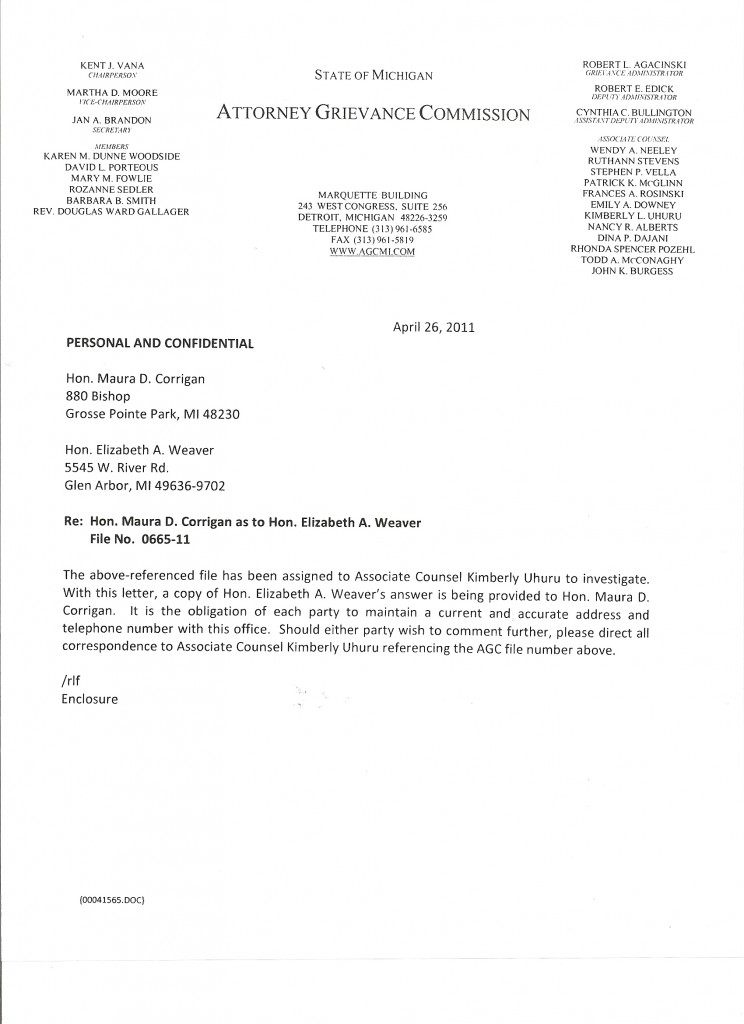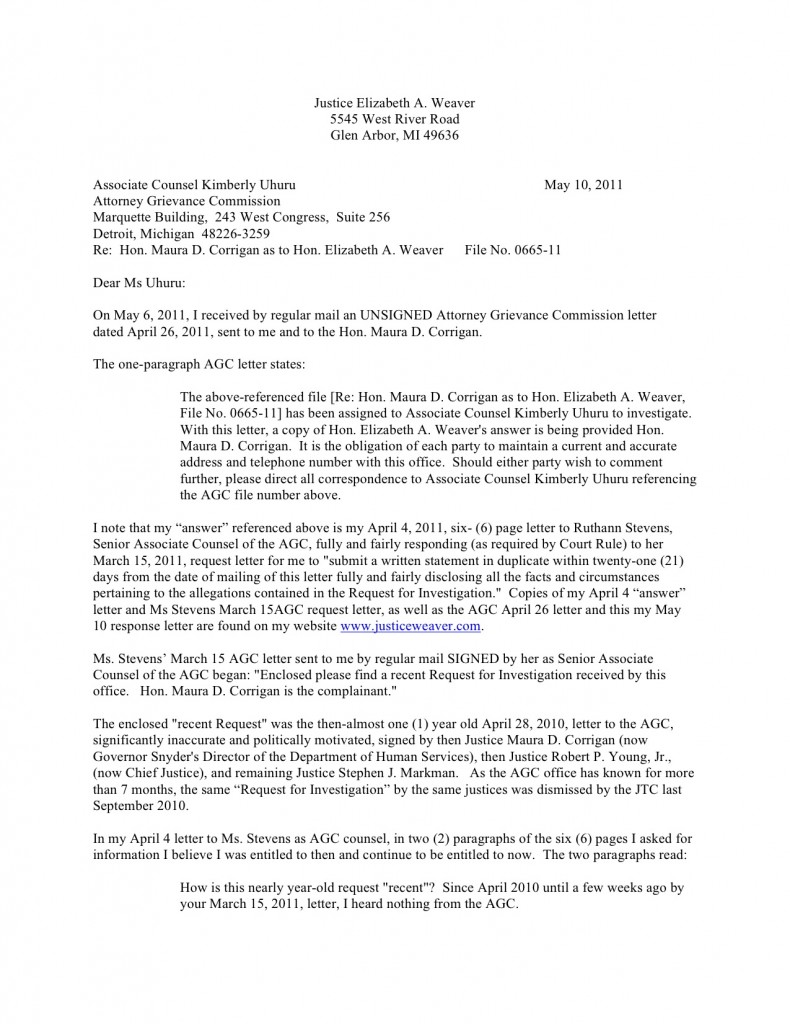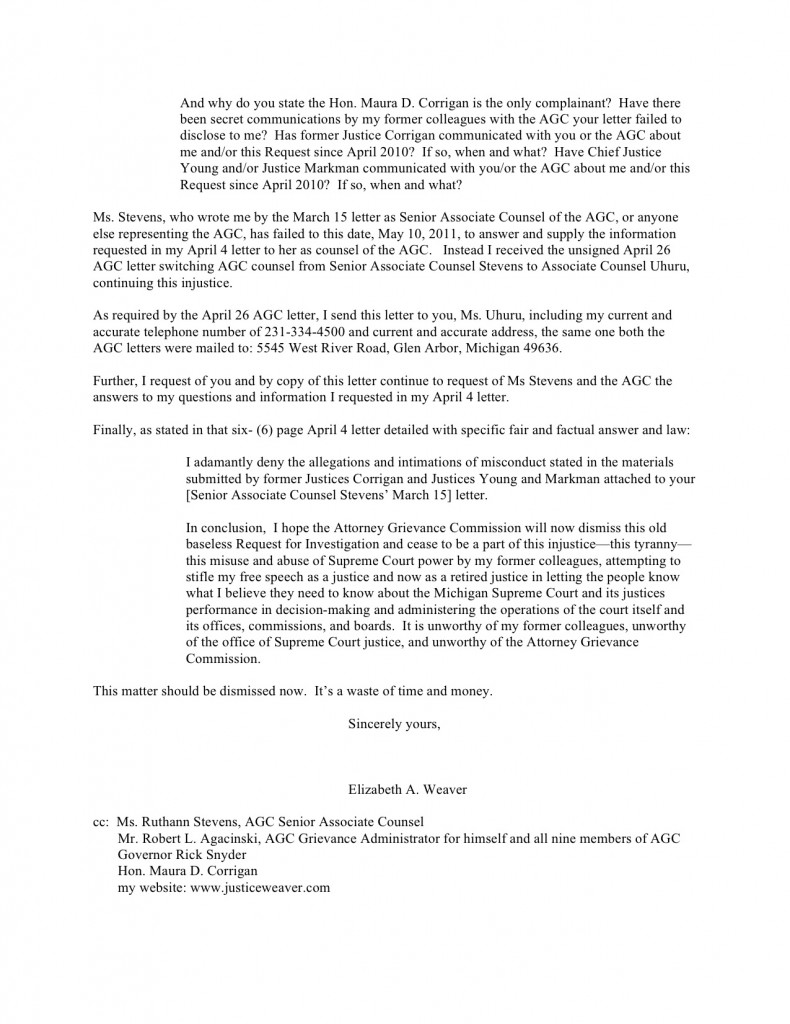…That’s what Bill Ballenger of Inside Michigan Politics called the continuing push by The Honorable Maura D. Corrigan in her drive to punish the Honorable Elizabeth A. Weaver. Both of them are former Michigan Supreme Court Justices. Justice Corrigan is listed as the sole complainant listed in the matter now before the Attorney Grievance Commission. What happened has been chronicled here.
At the time Justice Weaver revealed the notice of investigation, April 4, 2011, Ballenger suggested that it be dropped. It hasn’t been, and, in fact, is moving forward:
Justice Weaver has now posted her response at her website www.justiceweaver.com. It reads thusly:
“They should drop it and forget about it,” said Ballenger. “But I don’t know if they feel they can’t because some future justice could engage in something like this.”
The “this” is Justice Weaver speaking out, of telling Michigan citizens what she thinks they should know about operations at the court…in her words, “no more and no less.”
That matter of attempting to force compliance is still well in place, said Ballenger: “As far as I’m concerned the Gang of Four is still in control, only in place of [Cliff] Taylor now you have [Mary Beth] Kelly.” And, presumably, Brain Zahra…all of whom have been recipients of the political largess in the form of appointments by Governor John Engler.
The same was true of the original “Gang of Four,” a term that originated with Justice Weaver to describe the efforts of then-Chief Justice Cliff Taylor and Justices Corrigan, Robert Preston Young, Jr., and Steven Markman to stiffle her speech. They even passed what she calls the “illegal Gag Order” that seems to fly in the face of the state constitution and the state’s Code of Judicial Conduct.
“I don’t see what good this is doing,” said Ballenger of the continued AGC complaint. “There is nothing coming the other way [from Justice Weaver] that I know of.”
Justice Weaver has continued to speak out about excesses at the Court as an effort to secure support for reform.
“Yeah, but this is a free country and she can say anything she wants. She’s not going after Corrigan. [Gov.] Snyder ought to get to her [Justice Corrigan] and say ‘Get off this.’
“I don’t think it serves the justices well. […] This is unseemly–their continuing to flail around in the cesspool.”
And one of the signatories on the letter of complaint, Justice Markman, is up for reelection in 2013. This may not play well.
And that initial complaint letter of April 28, 2010, is well worth examining because it lists THREE Justices: Corrigan, Markman, and Young. And yet the letter from the AGC lists Justice Corrigan and the sole complainant. Is that the way things are done, to just list the first signatory? Or…?
It was worth a call.
Robert L. Agacinski is the Grievance Administrator for the AGC and he got on the phone quickly after I dialed. There was no hesitation. He was cheerful, forthcoming…but strictly in a hypothetical sense. We discussed NO SPECIFICS.
A case, he explained, could come either from a complaint or complaints. Or the AGC might hear something from someone about an attorney, whose conduct was worthy of investigation. The AGC possibly could even learn of actions from the news media, and take it upon itself to act. In such a case, the complaint would be signed by Mr. Agacinski. “In those cases we decide to act on our own authority,” he said. And that authority is as a licensing agency…whether or not an attorney gets to keep her or his law license.
In cases where his office hears from multiple sources that action should be taken, it may list one or all complainants on the notification…but only after contact with them by the AGC’s office. “The AGC would have to see if they wanted to be complainants.”
So, it’s theoretically possible that you might have three people who signed a letter. Each one would then be contacted to see who–if any of them–want to stand as the complainant. If none did, the matter might go forward under Mr. Agacinski’s authority if he thought it warranted. Or there might just me one of the three.
“Yes,” he said. Nor would he necessarily convey to the person being complained about the matter of such contact. “That generally would not be known unless the matter goes forward,” he said. “We do not reveal who all we talk with.”
The length of our hypothetical investigation seems long, especially because the AGC lists its resolution time…complaint to finding…at an average of six months. This hypothetical has been holding fire for more than a year, and it yet may be early in the investigation.
“Yes,” said Mr. Agacinski, “that could seem like a long time. But as a licensing agency we try not to affect cases where there are criminal proceedings or elections. There are reasons for when we start our investigations.”
Part of it may depend on when judge is no longer sitting. “We do not have judicial authority over a sitting judge,” he said.
That belongs to the Judicial Tenure Commission, the JTC. [This is from me, not Mr. Agacinski: That’s the organization that dismissed the non-hypothetical allegations by the three justices last spring. They filed charges with both the JTC and the AGC, a kind of scattergun approach.]
“But once she’s not a judge we have jurisdiction,” Mr. Agacinski said.
And the problems that might come from a hypothetical target of a hypothetical investigation revealing all?
“That makes it really awkward,” he said. “It’s tough when everybody knows what’s going on. The parties can talk about it if they want, but we can’t.”
No, indeed. And he didn’t.



